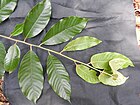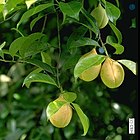Note: This is a project under development. The articles on this wiki are just being initiated and broadly incomplete. You can Help creating new pages.
Difference between revisions of "Myristica malabarica"
(Created page with "{{stub}} ==Uses== {{Uses|}}, {{Uses|}}, {{Uses|}}, {{Uses|}}, {{Uses|}}, {{Uses|}}, {{Uses|}}, {{Uses|}}, {{Uses|}}, {{Uses|}}, {{Uses|}}.<ref name="Uses"/> ==Parts Used== {{...") |
|||
| (2 intermediate revisions by 2 users not shown) | |||
| Line 1: | Line 1: | ||
| − | + | [[File:Myristica malabarica.jpg|thumb|right|'''Myristica malabarica''']] | |
| + | '''Myristica malabarica''' is a species of plant in the family Myristicaceae. It is endemic to the Western Ghats in southwest India. It is threatened by habitat loss according to the IUCN Red List. It can reach up to 25 m long and its bark is greenish black, smooth and sometimes reddish. | ||
==Uses== | ==Uses== | ||
| − | {{Uses|}}, {{Uses|}}, {{Uses|}}, {{Uses|}} | + | {{Uses|Fever}}, {{Uses|Bronchitis}}, {{Uses|Cough}}, {{Uses|Burning sensation}} |
==Parts Used== | ==Parts Used== | ||
| − | {{Parts Used|}}, {{Parts Used| | + | {{Parts Used|Fruits}}, {{Parts Used|Leaves}}. |
==Chemical Composition== | ==Chemical Composition== | ||
| + | The chemical constituents such as Malabaricones, Malabaricanol, Isoflavones are isolated. | ||
<ref name="chemical composition"/> | <ref name="chemical composition"/> | ||
==Common names== | ==Common names== | ||
| − | {{Common names | + | {{Common names|kn=Kanage, Doddajajikai|ml=Kattujathi, Kattujathikka|sa=Asana, Bandhukapushpa|ta=Colaivenkai, Katjathika|te=Adavijajikaaya, Adavijajikaya|hi=Bambay-jayphal, Van-jayphal|en=Malabar Nutmeg}} |
==Properties== | ==Properties== | ||
Reference: Dravya - Substance, Rasa - Taste, Guna - Qualities, Veerya - Potency, Vipaka - Post-digesion effect, Karma - Pharmacological activity, Prabhava - Therepeutics. | Reference: Dravya - Substance, Rasa - Taste, Guna - Qualities, Veerya - Potency, Vipaka - Post-digesion effect, Karma - Pharmacological activity, Prabhava - Therepeutics. | ||
===Dravya=== | ===Dravya=== | ||
| + | |||
===Rasa=== | ===Rasa=== | ||
| − | |||
===Guna=== | ===Guna=== | ||
| Line 29: | Line 31: | ||
==Habit== | ==Habit== | ||
| − | {{Habit|}} | + | {{Habit|Tree}} |
==Identification== | ==Identification== | ||
===Leaf=== | ===Leaf=== | ||
| − | {{Leaf|||}}<ref name="Leaf"/> | + | {{Leaf|Alternately arranged leaves|Elliptic or elliptic-oblong|9.5-22 x 3.7-10 cm, tip pointed, base narrow or flat, margin entire, glossy above, hairless and glaucous beneath, leathery.}}<ref name="Leaf"/> |
===Flower=== | ===Flower=== | ||
| − | {{Flower||| | + | {{Flower|Unisexual|Urn-shaped|White||Male flowers are numerous, smaller than female flowers, borne in cymes in leaf axils. Female flowers are borne in 5-6 flowered umbels. Capsule is 5-7.5 x 1.8-3.5, oblong}} |
| − | |||
| − | |||
| − | |||
===Other features=== | ===Other features=== | ||
| Line 46: | Line 45: | ||
==Where to get the saplings== | ==Where to get the saplings== | ||
| − | |||
==Mode of Propagation== | ==Mode of Propagation== | ||
| − | {{Propagation|}} | + | {{Propagation|Seeds}}. |
==How to plant/cultivate== | ==How to plant/cultivate== | ||
| − | <ref name="How to plant/cultivate"/> | + | They need the shade of woodland, especially when young, though can often tolerate more open positions as they grow larger. <ref name="How to plant/cultivate"/> |
==Commonly seen growing in areas== | ==Commonly seen growing in areas== | ||
| − | {{Commonly seen| | + | {{Commonly seen|Lowland forest}}. |
==Photo Gallery== | ==Photo Gallery== | ||
<gallery class="left" caption="" widths="140px" heights="140px"> | <gallery class="left" caption="" widths="140px" heights="140px"> | ||
| − | + | File:Myristica malabarica-2-mundanthurai-tirunelveli-India.jpg | |
| + | File:Myristica malabarica.jpg | ||
| + | File:Myristica fragrans by kadavoor.jpg | ||
| + | File:Spathodea companulata, African tulip tree, Fountaintree, -ഫൗണ്ടന്മരം. Flower .jpg | ||
</gallery> | </gallery> | ||
==References== | ==References== | ||
| + | |||
<references> | <references> | ||
| + | <ref name="chemical composition">[http://www.phytopharmajournal.com/Vol6_Issue6_04.pdf Chemical composition]</ref> | ||
| − | <ref name=" | + | <ref name="Leaf">[https://www.flowersofindia.net/catalog/slides/Malabar%20Nutmeg.html Morphology]</ref> |
| − | |||
| − | |||
| − | <ref name="How to plant/cultivate">[ | + | <ref name="How to plant/cultivate">[http://tropical.theferns.info/viewtropical.php?id=Myristica+malabarica Cultivation Details]</ref> |
| − | |||
</references> | </references> | ||
==External Links== | ==External Links== | ||
| − | * [ ] | + | * [https://www.iucnredlist.org/species/31219/9615327 Myristica malabarica on www.iucnredlist.org] |
| − | + | ||
| − | + | ||
[[Category:Herbs]] | [[Category:Herbs]] | ||
| + | [[Category:Myristicaceae]] | ||
Latest revision as of 12:42, 25 June 2020
Myristica malabarica is a species of plant in the family Myristicaceae. It is endemic to the Western Ghats in southwest India. It is threatened by habitat loss according to the IUCN Red List. It can reach up to 25 m long and its bark is greenish black, smooth and sometimes reddish.
Contents
- 1 Uses
- 2 Parts Used
- 3 Chemical Composition
- 4 Common names
- 5 Properties
- 6 Habit
- 7 Identification
- 8 List of Ayurvedic medicine in which the herb is used
- 9 Where to get the saplings
- 10 Mode of Propagation
- 11 How to plant/cultivate
- 12 Commonly seen growing in areas
- 13 Photo Gallery
- 14 References
- 15 External Links
Uses
Fever, Bronchitis, Cough, Burning sensation
Parts Used
Chemical Composition
The chemical constituents such as Malabaricones, Malabaricanol, Isoflavones are isolated. [1]
Common names
| Language | Common name |
|---|---|
| Kannada | Kanage, Doddajajikai |
| Hindi | Bambay-jayphal, Van-jayphal |
| Malayalam | Kattujathi, Kattujathikka |
| Tamil | Colaivenkai, Katjathika |
| Telugu | Adavijajikaaya, Adavijajikaya |
| Marathi | NA |
| Gujarathi | NA |
| Punjabi | NA |
| Kashmiri | NA |
| Sanskrit | Asana, Bandhukapushpa |
| English | Malabar Nutmeg |
Properties
Reference: Dravya - Substance, Rasa - Taste, Guna - Qualities, Veerya - Potency, Vipaka - Post-digesion effect, Karma - Pharmacological activity, Prabhava - Therepeutics.
Dravya
Rasa
Guna
Veerya
Vipaka
Karma
Prabhava
Habit
Identification
Leaf
| Kind | Shape | Feature |
|---|---|---|
| Alternately arranged leaves | Elliptic or elliptic-oblong | 9.5-22 x 3.7-10 cm, tip pointed, base narrow or flat, margin entire, glossy above, hairless and glaucous beneath, leathery. |
Flower
| Type | Size | Color and composition | Stamen | More information |
|---|---|---|---|---|
| Unisexual | Urn-shaped | White | Male flowers are numerous, smaller than female flowers, borne in cymes in leaf axils. Female flowers are borne in 5-6 flowered umbels. Capsule is 5-7.5 x 1.8-3.5, oblong |
Other features
List of Ayurvedic medicine in which the herb is used
Where to get the saplings
Mode of Propagation
How to plant/cultivate
They need the shade of woodland, especially when young, though can often tolerate more open positions as they grow larger. [3]
Commonly seen growing in areas
Photo Gallery
References
External Links
- Ayurvedic Herbs known to be helpful to treat Fever
- Ayurvedic Herbs known to be helpful to treat Bronchitis
- Ayurvedic Herbs known to be helpful to treat Cough
- Ayurvedic Herbs known to be helpful to treat Burning sensation
- Herbs with Fruits used in medicine
- Herbs with Leaves used in medicine
- Herbs with common name in Kannada
- Herbs with common name in Hindi
- Herbs with common name in Malayalam
- Herbs with common name in Tamil
- Herbs with common name in Telugu
- Herbs with common name in Sanskrit
- Herbs with common name in English
- Habit - Tree
- Index of Plants which can be propagated by Seeds
- Herbs that are commonly seen in the region of Lowland forest
- Herbs
- Myristicaceae




